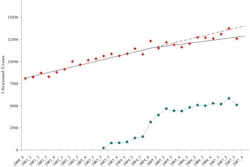Radiologists, show of hands: How many of you think your referring physicians are really listening when you make recommendations for patient care? Wouldn't it be great to have a tool that lets you track just how often your advice is followed?
Researchers from Indiana may have developed just such a tool in the form of decision-support software that tracks how often general practitioners follow recommendations made by specialist physicians. A pilot study of the software indicated that it led to a 30% increase in compliance with advice made by specialists, according to results published in the March/April 2009 issue of the Journal of the American Medical Informatics Association (Vol. 16, pp. 196-202).
The software was developed at the Regenstrief Institute in Indianapolis, a research institute specializing in health information and medical informatics, and implemented on a pilot basis at Wishard Health Services, also in Indianapolis.
Wishard Health Services is a 264-bed hospital that utilizes OpenMRS, an open-source electronic medical record (EMR) system developed at Regenstrief. Primary care physicians and clinical staff teams use its computerized physician order entry (CPOE) system, dubbed Medical Gopher, to enter all orders, including medication, laboratory tests, requests for radiology procedures, nursing orders, and consultant requests. Orders become active as soon as they are electronically signed.
Although the primary care doctors have gone digital, specialists at Wishard still write out their clinical notes and recommendations by hand. It's the responsibility of the primary care physicians and their clinical staff to determine if they wish to implement the recommendations and to add them to the inpatient's EMR if they concur with the notes and recommendations.
Dr. Martin Were, an internist at Wishard and an informatics fellow at Regenstrief, thought he could improve upon hand-written notes and therefore developed CRO Tool, a type of physician clinical-support software. CRO Tool enables specialist consultants to enter clinical recommendations that display prominently in an independent window for the primary care team to act upon.
Primary care physicians using CRO Tool can approve the recommendation and convert it into an order, reject and delete it, or ignore acting upon it. Specialist recommendations are kept in a separate database and not officially integrated into the CPOE system until selected for implementation with an electronic signature of a primary care physician. Upon patient discharge, recommendations that aren't acted upon are permanently deleted.
To test the effectiveness of the software, Were and colleagues compared its use over a 45-day period to 45 days of normal operation at Wishard with hand-written specialist recommendations for a group of patients older than 65 years. There were 20 patients in each group, with the study starting in December 2007.
The researchers found that 60% of the total number of recommendations recorded on paper were implemented versus 78% of the recommendations made using the CRO Tool, representing an increase of 30%.
Responses to a survey by 24 of the 36 primary care physicians who used CRO Tool were very positive. All survey respondents stated that CRO Tool saved time and prevented duplicate recommendations from being made. Another benefit cited was that specialists were able to see which of their recommendations were being implemented, which facilitated better communication between the two groups, according to the researchers.
None of the specialists requested that radiology exams be ordered in this small pilot study. However, the tool could be used as a reminder for additional diagnostic imaging procedures or follow-up procedures recommended by the interpreting radiologist.
After the pilot project, use of CRO Tool was not continued at Wishard. The software is in the process of being modified and expanded so that it will have additional utility for multiple specialties at the hospital, the authors reported in e-mail communication with AuntMinnie.com.
By Cynthia E. Keen
AuntMinnie.com staff writer
April 16, 2009
Related Reading
Regenstrief Institute gets WHO distinction, March 16, 2009
Integrating IT and QI for higher-quality patient care, November 11, 2006
Copyright © 2009 AuntMinnie.com



















